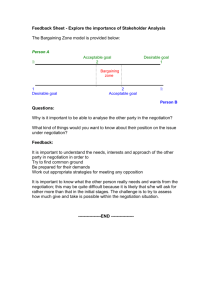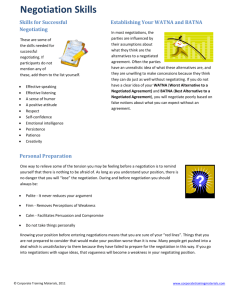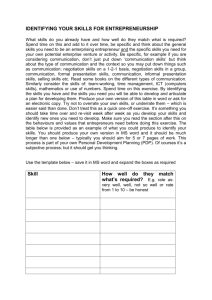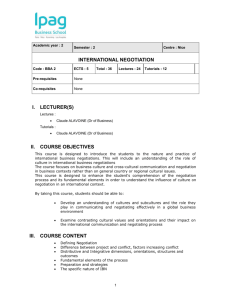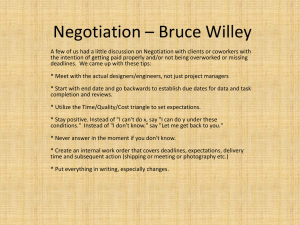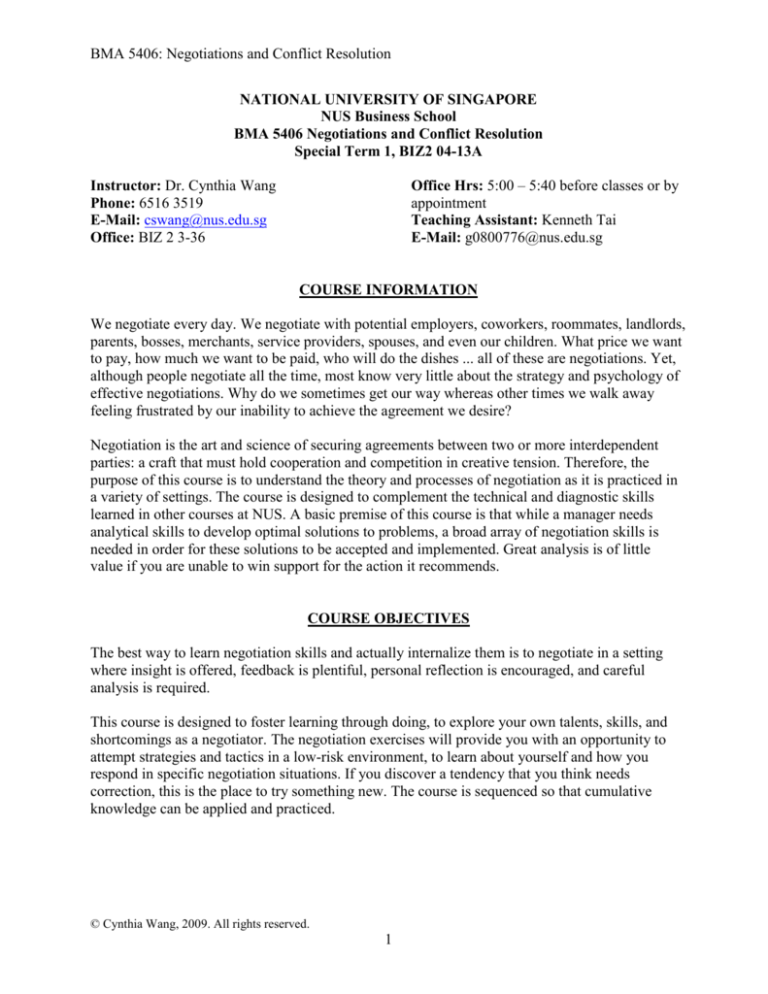
BMA 5406: Negotiations and Conflict Resolution
NATIONAL UNIVERSITY OF SINGAPORE
NUS Business School
BMA 5406 Negotiations and Conflict Resolution
Special Term 1, BIZ2 04-13A
Office Hrs: 5:00 – 5:40 before classes or by
appointment
Teaching Assistant: Kenneth Tai
E-Mail: g0800776@nus.edu.sg
Instructor: Dr. Cynthia Wang
Phone: 6516 3519
E-Mail: cswang@nus.edu.sg
Office: BIZ 2 3-36
COURSE INFORMATION
We negotiate every day. We negotiate with potential employers, coworkers, roommates, landlords,
parents, bosses, merchants, service providers, spouses, and even our children. What price we want
to pay, how much we want to be paid, who will do the dishes ... all of these are negotiations. Yet,
although people negotiate all the time, most know very little about the strategy and psychology of
effective negotiations. Why do we sometimes get our way whereas other times we walk away
feeling frustrated by our inability to achieve the agreement we desire?
Negotiation is the art and science of securing agreements between two or more interdependent
parties: a craft that must hold cooperation and competition in creative tension. Therefore, the
purpose of this course is to understand the theory and processes of negotiation as it is practiced in
a variety of settings. The course is designed to complement the technical and diagnostic skills
learned in other courses at NUS. A basic premise of this course is that while a manager needs
analytical skills to develop optimal solutions to problems, a broad array of negotiation skills is
needed in order for these solutions to be accepted and implemented. Great analysis is of little
value if you are unable to win support for the action it recommends.
COURSE OBJECTIVES
The best way to learn negotiation skills and actually internalize them is to negotiate in a setting
where insight is offered, feedback is plentiful, personal reflection is encouraged, and careful
analysis is required.
This course is designed to foster learning through doing, to explore your own talents, skills, and
shortcomings as a negotiator. The negotiation exercises will provide you with an opportunity to
attempt strategies and tactics in a low-risk environment, to learn about yourself and how you
respond in specific negotiation situations. If you discover a tendency that you think needs
correction, this is the place to try something new. The course is sequenced so that cumulative
knowledge can be applied and practiced.
© Cynthia Wang, 2009. All rights reserved.
1
BMA 5406: Negotiations and Conflict Resolution
In this course, I hope you will:
Experience the negotiation process, learning how to evaluate the costs and benefits of
alternative actions.
Improve your ability to analyze the negotiation situation and learn how to develop a
strategic plan so as to improve your ability to negotiate effectively.
Develop confidence in the negotiation process as an effective means for resolving conflict
in organizations.
Understand more about the nature of negotiations and gain a broad intellectual
understanding of the central concepts in negotiation.
Improve your analytical abilities and your capacity to understand and predict the behavior
of individuals, groups, and organizations in competitive situations.
Develop a toolkit of useful negotiation skills, strategies, and approaches.
COURSE FORMAT
The course is highly experiential, and is therefore built around a series of negotiation exercises,
debriefings, and readings. There will be a negotiation exercise in every class. Classes will also
include lectures and class discussions.
Almost all exercises require preparation in advance. Some exercises require students to prepare
outside of class as a team, either by phone, e-mail, or in person. Students are expected to be fully
prepared for exercises prior to class and to participate in the debriefings. Students should also be
prepared to stay a few minutes after class to arrange meetings with other members of the class.
It is important to do the week’s readings AFTER class. Please do not read ahead. I have
selected readings to reinforce the learning points of each exercise, and the concepts will be more
comprehensible if you have already experienced them directly.
COURSE MATERIALS
Fisher & Ury. (1981) Getting to Yes: Maybe purchased at the NUS Co-op.
Handouts: Readings will be available online. Negotiation materials will be handed out in class.
COURSE REQUIREMENTS AND GRADING
Your grade will be made up of:
1.
Course contribution
2.
Post-negotiation analysis
3.
Negotiation planning documents
4.
On-going Team Negotiation
5.
Real world negotiation analysis (w/ planning document)
© Cynthia Wang, 2009. All rights reserved.
2
15%
20%
15%
15%
35%
BMA 5406: Negotiations and Conflict Resolution
1. Course Contribution: Attendance and Participation in Class Discussions (15% of grade)
Because negotiation exercises are critical to the learning process in this course, students are
expected to participate in all of them. If you must miss an exercise, it is your responsibility to
contact Kenneth at least three days before the class session.
Your participation in class discussion will be evaluated on the quality of your contributions and
insights. You are expected to be prepared for class and actively participate in all class discussions
and negotiation exercises. You will be evaluated on the quality of your contribution to class
discussions. Quality comments possess one or more of the following properties:
1. Offer a different and unique, but relevant, perspective based upon analysis and theory (not
intuition or casual observation)
2. Contribute to moving the discussion and analysis forward
3. Transcend the “I feel” syndrome (i.e., include evidence, demonstrate recognition of basic
concepts, and integrate these with reflective thinking)
4. Link relevant concepts to current events and experiences
2. Negotiation Role Planning Documents (15% of grade)
Because negotiation exercises are critical to the learning process in this course, you should be fully
prepared for every negotiation. To help you prepare for the role you will play in each negotiation,
you should prepare a planning document before each negotiation. If you are negotiating as part
of a team, you and the other team members should prepare one planning document together. An
example of a planning document is included at the end of this syllabus.
You or your team (if you are negotiating as a team) should bring 2 copies of the assigned
planning documents to class so that you can turn one copy in at the beginning of class and use the
other as a reference during your negotiation. Please submit the following planning documents to
Kenneth before the negotiation (email format preferred):
Moms.com (with your teammate): graded on a / system (1% of grade).
Bullard Houses: 10% of grade
ABC/Local Round 1(as a team): / system (1% of grade)
ABC/Local Round 2(as a team): / system (1% of grade)
ABC/Local Round 3(as a team): / system (1% of grade)
Viking: / system (1% of grade)
3. Post-Negotiation Analysis (20% of grade)
You will be required to turn in a post-negotiation analysis. This analysis consists of two parts: 1)
an analysis of an in-class negotiation and 2) an application of these learnings from your in-class
negotiation analysis to a real-life negotiation you have personally experienced or seen in the news.
Part 1: In-class analysis
You can provide an analysis on any of the following negotiation exercises: Biopharm-Seltek, New
Recruit, or Moms.com. The purpose of this analysis is to encourage you to reflect on your behavior
© Cynthia Wang, 2009. All rights reserved.
3
BMA 5406: Negotiations and Conflict Resolution
and your classmates’ behaviors in a negotiation exercise, and to analyze what you have learned
from your experience. Your analysis will also give me a sense of your individual progress and
provide me with an idea of which topics require more class discussion. Your task in this postnegotiation analysis is to describe your reactions, perceptions, and significant insights gained from
participation in a negotiation exercise. The analysis should not be a detailed report of everything
that happened in the negotiation. Rather, it should focus on the following issues:
1. Provide a brief overview of the key events.
2. What were the critical factors that affected the negotiation situation and outcomes, and
what can you say about these factors in general?
3. What did you learn about negotiation or conflict from this situation?
4. How do the concepts presented in lectures or readings enrich your understanding of the
process of this negotiation, its outcome, or your own style?
5. What would you do the same or differently in the future, or how would you like to behave
in order to perform more effectively?
Part 2: Application of analysis
The second part of the analysis is to apply your in-class learnings from the in-class negotiation to a
real-life negotiation – either one you have personally experienced or have seen in the news. This
part of the analysis should answer one following questions:
1. How does the in-class experience compare to others that you experienced under similar or
comparable circumstances?
OR
2. How does this experience provide insight into a recent negotiation you have seen in the
news? (Examples of topics include the Google-Yahoo-Microsoft negotiation (2008); ongoing Taiwan-China negotiations; recent Israeli elections (2009)).
A “good” entry is one that tries to step back from a negotiation, identifies key events and
processes, uses readings to help structure the analysis, and is written well.
The post-negotiation analysis should be 3-4 typed pages (no longer than four pages, doublespaced, Times 12 point font, and 1-inch margins) and is due on Class 5 (you may also submit it
earlier in class or via e-mail). Part 1 should be approximately three pages; Part 2 should be about
one page long. You are encouraged to share your post-negotiation analysis with the other people
who were involved in your negotiation; your feedback could be quite helpful to your peers.
4. On-going Team Negotiation (15% of grade)
You will be working in a team with other classmates on a multi-round negotiation. Your team will
be assigned either the role of union negotiators or management representatives, and will be paired
with another team for three rounds of negotiations. Your team will work together to develop
negotiating strategies and complete the negotiations.
Before each of the three negotiations, you will receive detailed information regarding the
negotiation. After each negotiation, your team should turn in the outcomes of the negotiation. In
© Cynthia Wang, 2009. All rights reserved.
4
BMA 5406: Negotiations and Conflict Resolution
addition, after the first round your team will be asked to turn in the scoring system you developed
for the negotiation. We will talk more about scoring systems in class.
Round 1 Scoring System (10% of grade)
The scoring systems developed by your team will be evaluated as part of your overall grade. In
particular, the scoring system you design for the first round will constitute 10% of your grade.
Your scoring systems will be graded based on your understanding and application of an additive
scoring system and your integration of issues in the case, and should be emailed to me the end of
the night of Class 6, at the very latest.
Round 2 Outcome for On-going Negotiation (5% of grade)
For the second round, each team’s outcomes will count for 5% of your grade. This grade will be
based on how well your results compare to those of your peers in the same role. This on-going
negotiation is the only instance in which your performance in a negotiation exercise will affect
your grade. Your outcomes can be submitted to Kenneth via email the night of the negotiation
(Class 8).
5. Real World Negotiation Analysis (35% of grade)
Although our course on negotiations has just begun, you have all been negotiating for years –
perhaps without even thinking about the exchanges as negotiations. Likewise, in the past, you
have probably overlooked many opportunities for potential negotiations. To encourage you to
think about the many everyday opportunities you have to negotiate, and to improve your
negotiation skills, you are being asked to go out and negotiate!
You can negotiate for anything you would like. Be creative. Your negotiation could involve a
good or service from a merchant, a salary or bonus with an employer, a discount from a service
provider, or anything else. Also, note that you do not have to buy anything to complete this
assignment (e.g., negotiating with a child over bedtime). Similarly, your negotiations do not need
to be a success – often, we learn as much from negotiations that fail as from those that succeed.
There are only two rules for this assignment:
1. You may not tell the person you are negotiating with that this is for a class project until the
negotiation is complete (and even then, it’s probably not necessary).
2. You are not allowed to engage in a negotiation that you do not intend to follow through
with if the outcome you desire is obtained.
After you have finished negotiating, you should write an analysis of the negotiation that includes a
planning document, scoring system (if applicable), and a post-negotiation analysis. To understand
how to format and write the analysis, please follow the instructions for the in-class postnegotiation analysis. Your analysis should be 4-6 typed pages (no longer than 6 pages, doublespaced, Times 12 point font, and 1-inch margins). This paper is not due until Class 12, so you
should have plenty of time to find an interesting negotiating opportunity. As with the postnegotiation analysis, the key is to focus on an analysis rather than a description of the negotiation.
Your grade for this project will be based on your creativity and your analysis of the preparation,
process, and outcome of the negotiation.
© Cynthia Wang, 2009. All rights reserved.
5
BMA 5406: Negotiations and Conflict Resolution
Extra Credit
You can earn an extra credit point in the course by posting an article on negotiations in the popular
press or examples of interesting negotiations from movies, television shows, comic strips, etc. This
input oftentimes results in enriched class discussions or further development of the course. The
references must illustrate a concept from the course and you must write a few sentences of how it
relates to the concepts discussed in class or in the readings. For example, if you see a noteworthy
negotiation in a movie, just write a brief description of it, provide the name of the movie, and note
when (approximately) the negotiation occurs in the movie. Post the item and write-up on IVLE for
credit, so others can also enjoy. Finally, only high quality submissions will receive credit – last year,
a fair number of the submissions were sub-par, which caused more clutter and chaos than interest!
ATTENDENCE POLICY
If you must miss an exercise, it is your responsibility to contact me. With at least three days
notice, please e-mail Kenneth Tai at g0800776@nus.edu.sg. If you have last minute emergencies
that necessitate missing class, please contact me on my mobile phone at 9146-3415. This strict
policy is necessary because your classmates rely on your attendance for their educational
experience, and because instructors must arrange logistics and pairings in advance.
HONOR CODE
The honor code applies to this class as follows:
You may use any strategy, short of physical violence, to reach an agreement, including
misrepresentation. However, in selecting a negotiation strategy it is important to remember
that a strategy may have ramifications that go beyond the particular negotiation in which it
was used.
You may not make up facts that materially change the power distribution of the exercise,
e.g., your family just bought the company with which you are currently negotiating. If you
are asked a question that calls for information that is not in your confidential instructions,
you may say, “I don’t know.”
You may tell the other side what you wish, but do not show them your confidential role
instructions.
It is not appropriate to borrow notes or discuss cases with people outside of class.
Class discussion stays in class.
Material used in this class including but not limited to handouts, exercises, cases,
discussion questions, charts, and graphs are copyrighted and may not be used for purposes
other than the education experience of this class without the written consent of the
instructor.
RESEARCH
The research at NUS has been instrumental in developing the University’s reputation as one of the
premier institutions for teaching negotiations. As a result, cutting-edge research on negotiations is
conducted at NUS. You have an opportunity to benefit from this research in this course. Just as
© Cynthia Wang, 2009. All rights reserved.
6
BMA 5406: Negotiations and Conflict Resolution
prior NUS students have contributed to your learning experience by participating in research, you
contribute to the experiences of future students. If you do not want your outcomes from any
exercise used for research purposes, please notify me. Negotiation results for research purposes
are always aggregated and anonymous.
THE NEGOTIATOR’S LIBRARY
Babcock, L, & Laschever, S. (2003). Women Don’t Ask. New Jersey: Princeton University Press.
Bazerman, M. H. & Neale, M.A. (1992). Negotiating Rationally. New York: Free Press.
Brett, J. M. (2001). Negotiating Globally: How to Negotiate Deals, Resolve Disputes, and Make
Decisions across Cultural Boundaries. San Francisco, CA: Jossey-Bass.
Fisher, R., Ury, W. L., & Patton, B. (1991). Getting to Yes. Boston: Houghton Mifflin.
Lewicki, R. J., Litterer, J. A., Minton, J. W., & Saunders, D. M. (1994). Negotiation (2nd ed.),
Boston: Irwin, 1994.
Malholtra, D. & Bazerman, M. (2008). Negotiation Genius: How to Overcome Obstacles and
Achieve Brilliant Results at the Bargaining Table and Beyond. Bantam Books.
Raiffa, H. (1982). The Art and Science of Negotiation. Cambridge: Harvard University Press.
Shell, R. (1999). Bargaining for Advantage. New York: Viking.
Ury, W. L., Brett, J. M., & Goldberg, S. B. (1988). Getting Disputes Resolved. San Francisco:
Jossey-Bass.
Ury, W. (1991). Getting Past No: Negotiation with Difficult People. Bantam Books.
© Cynthia Wang, 2009. All rights reserved.
7
BMA 5406: Negotiations and Conflict Resolution
Date
Topic
In Class
Assignments Due Today
Class 1
Introduction to
Negotiations
Prepare Biopharm-Seltek
Read Ury & Williams: Getting to Prepare role for New Recruit
Yes, Chapter 1-4, before coming
to class
Negotiate Biopharm-Seltek
Simple, Two-Party
Negotiations
Class 2
Debrief Biopharm-Seltek
After Class - To Do
Bazerman & Neale: Thinking
rationally about negotiating
Lewicki, Saunders, & Minton:
Strategy and tactics of
distributive bargaining
Answer and email 2 questions to
g0800776@nus.edu.sg before
coming to class
Multiple Issue, Two- Negotiate New Recruit
Party Negotiations
Debrief New Recruit
After Class – To Read
Prepare role for Moms.com
Lax & Sebenius: Interests: The
measure of negotiation
Lax & Sebenius: The
Negotiator’s Dilemma: Creating
and Claiming Value
Class 3
Beyond "Win-Win"
Negotiate Moms.com
Debrief Moms.com
Class 4
Intra-team
Negotiations
Prepare Globesmart
Negotiate Globesmart
Debrief Globesmart
One planning document per
negotiating team for Moms.com
(Graded or 0)
Write post-negotiation analysis Thompson: Win-win
negotiations: Expanding the pie
Hammond, Keeney, Raiffa:
Even Swaps: A rational method
for making tradeoffs
Post-negotiation analysis for
Prepare role for Bullard Houses Thompson: Team Decision
Biopharm-Seltek, New Recruit, or
Making, Pitfalls and Solutions
Moms.com (20% of grade)
Preparing for your Team-onTeam Negotiation
Class 5
Agents and Ethics in Negotiate Bullard Houses
Negotiations
Debrief Bullard Houses
Planning document for Bullard
Houses (10% of grade)
Class 6
On-going Negotiation Prepare ABC/Local 190 Rnd 1 Scoring system for ABC/Local
Round 1
190 Round 1 (E-mail me the preNegotiate ABC/Local 190 Rnd 1 negotiation scoring system and
outcomes when you finish Round
1, at the end of the night)
© Cynthia Wang, 2009. All rights reserved.
8
Begin preparing your role for
Malholtra & Bazerman:
ABC/Local 190 Round 1 – you Recognizing and resolving
will also be given some time to ethical dilemmas
prepare with your team at the
beginning of the next class.
BMA 5406: Negotiations and Conflict Resolution
Date
Topic
In Class
Class 7
Power, Trust, and
Influence
A Little Game
Assignments Due Today After Class - To Do
After Class – To Read
Cialdini: Harnessing the Science
of Persuasion
Film: 12 Angry Men
Malholtra: Six Ways to Build
Trust in Negotiations
Class 8
On-going Negotiation Negotiate ABC/Local 190 - Rnd 2
Round 2
Prepare role for Viking
Class 9
Dispute Resolution
Prepare role for ABC/Local 190 Lytle, Brett & Shapiro: The
Round 3 (negotiated on 5/24)
Strategic Use of Interests,
Rights, and Power to Resolve
Disputes
Negotiate Viking
Debrief Viking
Class 10 On-going Negotiation: Prepare and Negotiate ABC/Local Outcome for ABC/Local 190
Round 3
Round 3
Round 3 (e-mail outcome by
end of night)
Class 11 Multi-Party
Negotiations and
Coalitions
Debrief ABC/Local 190
Malholtra & Bazerman:
Negotiating from a Position of
Weakness
Prepare role for Social Services
Negotiate Social Services
Debrief Social Services
Class 12 Multiparty, CrossPrepare Mouse
Cultural Negotiations
Negotiate Mouse
Wrap-up
Debrief Mouse
Real world negotiation
© Cynthia Wang, 2009. All rights reserved.
9
BMA 5406: Negotiations and Conflict Resolution
PLANNING DOCUMENT
Before every negotiation (both in class and in the real world) you should construct a planning
document. The purpose of the planning document is threefold:
1. It will help you prepare systematically for negotiations.
2. Some weeks you will have a partner on your own side of the table with whom you will
develop and implement your negotiation strategy. Having completed a planning document
will expedite your strategy session with your partner.
3. It will help you transfer the negotiation skills you learn in class to negotiations you will do
outside of class.
Preparation is a vital part of the negotiation process. Time spent in preparation should focus on
assessing your interests and goals and those of your opponent. The more complete the information
you have about yourself and your opponent, the more control you can assume over your own
actions and reactions during the negotiation process. When you don’t have information, especially
about your opponent, GUESS. One way of beginning the negotiation process is to ask questions to
try to fill in gaps in the information you have, or to test the assumptions you made in your guesses.
The Planning Document Form on the following page is provided for your use in class. The form
asks for information about both yourself and your opponent. Feel free to modify the existing form
in any way that helps you to prepare for your negotiations. As the course progresses and new
concepts are added, you may wish to change the format of your planning document. Just make
sure that you do not leave out any of the basic concepts in doing so.
© Cynthia Wang, 2009. All rights reserved.
10
BMA 5406: Negotiations and Conflict Resolution
Name(s):
______
PLANNING DOCUMENT FORM
Negotiation:
Role:
What issues are most important to you (e.g., what are your interests)? List in order of importance
and add more issues if necessary (in parenthesis list your position on each issue)
1.
2.
3.
4.
5.
What is your BATNA? Reservation Price? Target?
What are your sources of power?
What issues are most important to your opponent (e.g., what are their interests)? List in order of
importance, add more issues if necessary (in parenthesis list their expected position on each
issue).
1.
2.
3.
4.
5.
What is your opponent’s BATNA? Reservation Price?
What are your opponent’s sources of power?
What is your opening move/first strategy? Other important information? You should also create
contingencies and plans of action given potential moves by your opponent.
© Cynthia Wang, 2009. All rights reserved.
11


